JULIAN OF NORWICH, HER SHOWING OF LOVE
AND ITS CONTEXTS ©
1997-2024 JULIA BOLTON HOLLOWAY
|| JULIAN OF NORWICH || SHOWING OF
LOVE || HER TEXTS ||
HER SELF || ABOUT HER TEXTS || BEFORE JULIAN || HER CONTEMPORARIES || AFTER JULIAN || JULIAN IN OUR TIME || ST BIRGITTA OF SWEDEN
|| BIBLE AND WOMEN || EQUALLY IN GOD'S IMAGE || MIRROR OF SAINTS || BENEDICTINISM ||
THE CLOISTER ||
ITS
SCRIPTORIUM || AMHERST MANUSCRIPT || PRAYER|| CATALOGUE AND PORTFOLIO (HANDCRAFTS, BOOKS
) || BOOK REVIEWS || BIBLIOGRAPHY ||
PILGRIMAGE TO
CLARE AND FRANCIS
 e made a pilgrimage to Assisi and to Rome this
Jubilee, taking the train from Florence to Santa Maria degli
Angeli and its Porziuncola, spending the night there,
catching the first bus into Assisi and in the dawning light
walking down pilgrim stairs to San Damiano.
e made a pilgrimage to Assisi and to Rome this
Jubilee, taking the train from Florence to Santa Maria degli
Angeli and its Porziuncola, spending the night there,
catching the first bus into Assisi and in the dawning light
walking down pilgrim stairs to San Damiano.
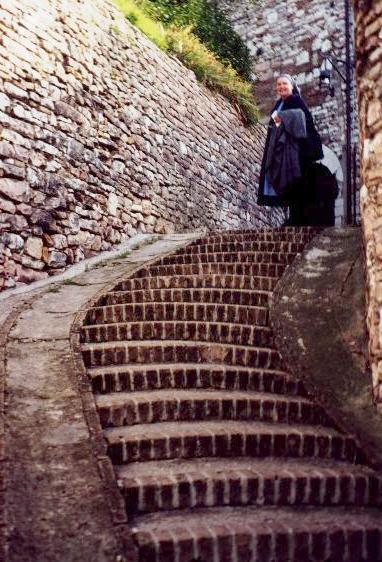
This is where St Francis had heard and seen the Cross speak to him, 'Francis,
repair my church. It is all falling in ruins'. Francis first
repaired San Damiano, then realized he was meant to repair the
entire Church of Christendom. He later gave San Damiano to
Clare and her 'ladies' wed to Holy Poverty.

Giotto, St Francis and Crucifix at St Damian,
Basilica, Assisi

Copy of San
Damiano Crucifix, original now in Santa Chiara, Assisi
St Francis began our practice
of placing the Child in the Manger at Christmas at Greccio
in 1223. Carmo and I could not travel there. But I had gone
many years ago, with my children when they were small, our
delighting in the birds singing in cages against the cliff.
When Giotto painted this scene he did not give it in the
cramped Greccio chapel but as if taking place in the Assisi
Basilica within which this scene is painted.
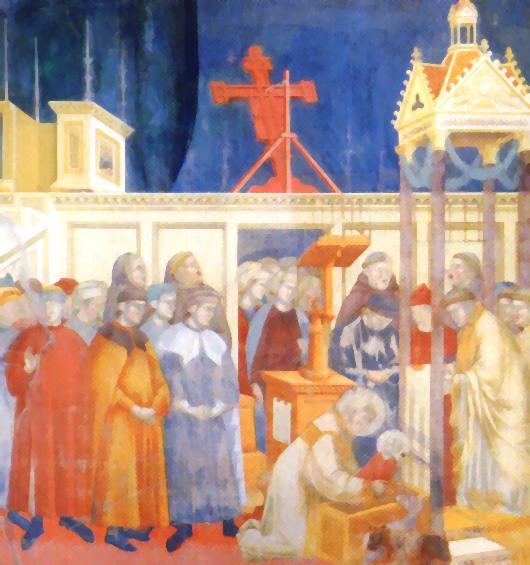
Giotto, St Francis' Presepio at Greccio, Basilica,
Assisi
Nor would Carmo and I go to Mount Alverna, the place
of St Francis's stigmatization, a similar place of great
cliffs above valleys.
Francis and Clare had been rich, privileged young
people. Francis, the merchant's son, stripping off his rich
clothing in front of the Bishop of Assisi and being clothed in
the episcopal cope, though he never became more than mere
deacon, never sought the priesthood. That cathedral is San
Rufino, and beside it Clare was
born and lived as a child.

Cathedral Piazza, St Clare's Birthplace
Above its great door, fitting to this Jubilee year,
sculpted in Assisi's pink stone, is the Woman Clothed with the
Sun, nursing her Child, escaping from the great Beast, beside
God enthroned between the Moon and the Sun, and then St John
writing the Book of his Vision of the Apocalypse.
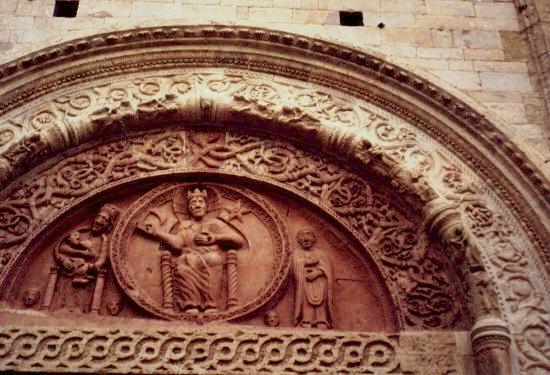
San Rufino, West Portal with Apocalypse

San Rufino, Door with Peacocks
The Romanesque art of Assisi runs riot in its
cathedral with similar forms to those we see in Assisi's
cross-stitch embroidery of blue on white,

of griffins and lions and
peacocks, and in the hand-loomed cloth of Farfa Sabina,
glimpsed in the altar cloth above of the Greccio miracle,
motives which go back to ancient Babylon, repeated down the
centuries in a women's literacy.

It was first to San Damiano, and then to the church
which became Santa Chiara, that St Francis' body was brought
from the Porziuncola.
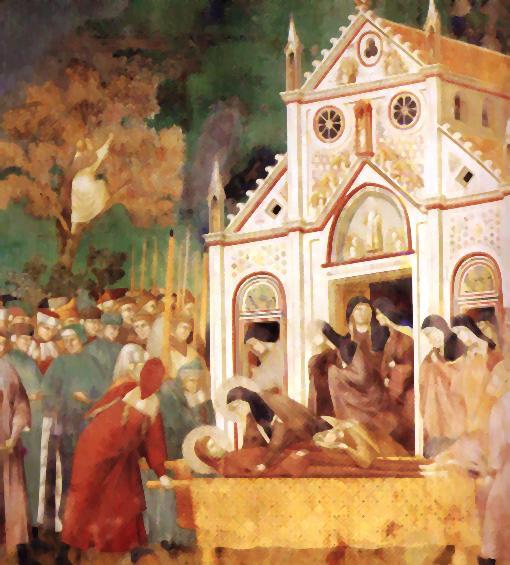
Giotto's Assistants, St Clare and St Francis at San
Damiano. Basilica, Assisi
After Clare's death her body too was brought to
Santa Chiara and her ladies moved there, preserving St
Francis' charism far better than did Fra Elia, building his
vast Basilica from amassed shekels, to which St Francis' body
was then taken. Franciscans split into two, the Conventuals in
their black robes, the Spirituals in their brown, the
Conventuals having the physical heritage, the body of the
saint, the Spirituals, the spiritual heritage, of humility, of
poverty.
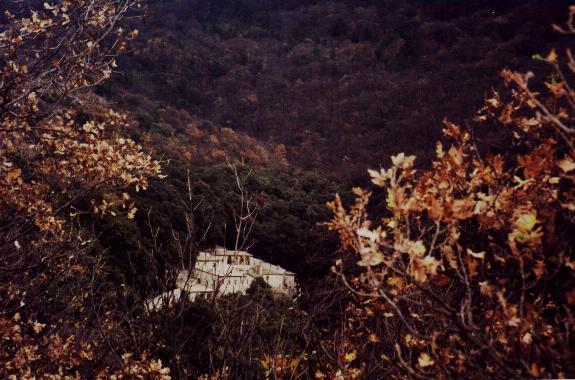
Eremo dei Carceri
But during Francis' lifetime was always the desire,
like Christ's, to renew himself in prayer through removing
himself from the world, an especial retreat of his being the
Eremo dei Carceri in the mountains above Assisi. It was here
St Francis preached to the birds. Here we saw white doves
amidst Autumn foliage.
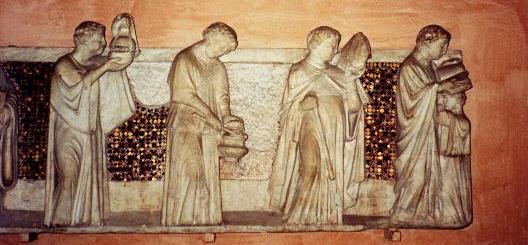
Arnolfo da Cambio, Sculpture in the Cloister, the
Lateran Basilica
St Francis sought the approval of his Rule, based on
the Gospel, on Poverty, Chastity and Obedience, the three
knots to the girdle of rope, from the Pope in Rome, then at
the Lateran, not the Vatican. Above we see the wealth of the
Lateran, an ecclesiastical procession of censor bearer,
incense boat bearer, mitre bearer, and lector with acolyte
holding his lectionary, against a rich background of gold and
coloured mosaic. We too on our pilgrimage came to Rome, first
St Peters, but the crowds were too great, then the Lateran,
whose Holy Door is the original Holy Door, later copied at the
Vatican, and there made our confessions to Franciscans and
passed through it.
St Francis' Rule was not acceptable at first to the
Pope. It had to be rewritten again and again, stripped of the
Gospel, made legalistic. Clare
preserved the original for her ladies. The Conventuals omit
Clare from their documents about Francis. The Pope dreamed of
Francis holding up the great Basilica of the Lateran from
toppling in an earthquake, so finally granted him the
much-altered Rule.
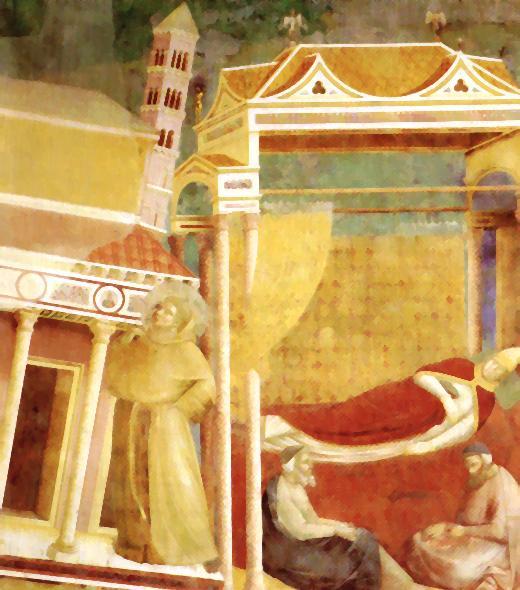
Giotto, Pope's Dream of Francis Supporting Lateran,
Basilica, Assisi
When we walked through Assisi's streets we could
still see the effects of the great Jubilee Earthquake, Brother
Elia's Conventual Basilica now all rebuilt, but Santa Chiara's
Protomonastery, lacking wealth, still in scaffolding, likewise
the Spirituals' Nuova Chiesa still needing repair. (If you
could send help, please do to 'Madre Abbadessa,
Protomonasterio S. Chiara, Piazza S. Chiara 1, Assisi,
Italy'.)

Cloister, Convento di San Francesco, Fiesole
Meanwhile Francis' message of peace went out into
the whole world, cloister upon cloister for prayer,
symbolizing Paradise, being built in the midst of cities, or
even founding cities, among them San Francisco, Franciscans
journeying to the Orient, to the Americas, to far California,
to far China. Here such a Paradise is found in Fiesole.
December, 2000, '{O Sapientia'. Photographs, Carmo Silva
This
morning, in March 2004, I walked into Annibale Niccolai's shop
here in Florence to ask the prices of the wooden carved St
Francis and Wolf low down in the window, and then to
photograph them where he placed them on a table in front of
one of his paintings. Annibale never repeats himself, each
piece being unique. Once I remember an antiquarian had in his
shop window nearby a great Baroque piece of a woman saint in
ecstasy, her nuns' garments swirling about her in clouds, and
I so yearned to purchase the version Niccolai made of it, that
exactly copied its style, its atmosphere, in miniature. He
both carves and paints. His address was Piazza Pitti, 20red.

I first photographed them from above, loving
Francis' humility. 'No', Annibale Niccolai said, I had to sit
down and take another.

Go to the Rule of St Clare
Go to the Privilege of Poverty
Go to Ursula Betka, Lauda to
St Francis
JULIAN OF NORWICH, HER SHOWING OF LOVE
AND ITS CONTEXTS ©
1997-2024 JULIA BOLTON HOLLOWAY || JULIAN OF NORWICH || SHOWING OF
LOVE || HER TEXTS ||
HER SELF || ABOUT HER TEXTS || BEFORE JULIAN || HER CONTEMPORARIES || AFTER JULIAN || JULIAN IN OUR TIME || ST BIRGITTA OF SWEDEN
|| BIBLE AND WOMEN || EQUALLY IN GOD'S IMAGE || MIRROR OF SAINTS || BENEDICTINISM ||
THE CLOISTER ||
ITS
SCRIPTORIUM || AMHERST MANUSCRIPT || PRAYER|| CATALOGUE AND PORTFOLIO (HANDCRAFTS, BOOKS
) || BOOK REVIEWS || BIBLIOGRAPHY ||
 e made a pilgrimage to Assisi and to Rome this
Jubilee, taking the train from Florence to Santa Maria degli
Angeli and its Porziuncola, spending the night there,
catching the first bus into Assisi and in the dawning light
walking down pilgrim stairs to San Damiano.
e made a pilgrimage to Assisi and to Rome this
Jubilee, taking the train from Florence to Santa Maria degli
Angeli and its Porziuncola, spending the night there,
catching the first bus into Assisi and in the dawning light
walking down pilgrim stairs to San Damiano.















